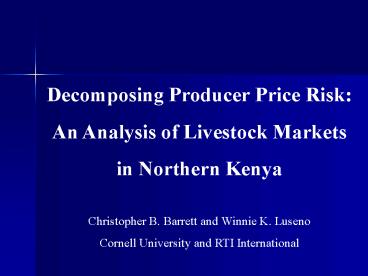Decomposing Producer Price Risk: - PowerPoint PPT Presentation
Title:
Decomposing Producer Price Risk:
Description:
To apply method to livestock markets in northern Kenya, which suffer significant ... Local markets' institutional design (e.g., auctions) are then key. ... – PowerPoint PPT presentation
Number of Views:22
Avg rating:3.0/5.0
Title: Decomposing Producer Price Risk:
1
Decomposing Producer Price Risk An Analysis of
Livestock Markets in Northern Kenya Christopher
B. Barrett and Winnie K. Luseno Cornell
University and RTI International
2
Motivation
- Producer price volatility in agricultural
markets - a significant disincentive to market
participation and agricultural production - particularly important in settings where
producers have little or no access to financial
markets cause consumption crises - Price stabilization - a real concern for producer
groups and policymakers - Locating the source(s) of price variability is
important for identifying effective intervention
strategies
3
Objectives
- To introduce a simple method to determine the
extent to which producer price risk is
attributable to - volatile inter-market margins
- intra-day variation
- intra-week (day of week) variation, or
- seasonality
- To apply method to livestock markets in northern
Kenya, which suffer significant inefficiencies
due to - high transactions costs
- difficulties in contract enforcement
- physical insecurity
- poor infrastructure
4
Method
Decompose price for any individual transaction as
follows
i individual transaction t individual day w
specific week p price in one market (e.g.,
the source market) p price in another market
(e.g., destination/terminal mkt)
5
Intuition Behind Decomposition
- It represents intraday variation due to
prevailing transactional institutions and
associated information advantages (e.g., auctions
versus dyadic exchange) - Mt captures intra-week variability due to market
thickness and day-of-week effects. - Bt reflects variation in intermarket spreads
(i.e., volatility in basis). - St captures seasonality and world market cycle
effects. - p reflects mean central market price.
6
Variance Decomposition
Just take the variance of this expression and
rearrange terms to isolate 4 sources of producer
price variability (each term is variance plus
covariances, e.g., BR V(B) S COV(B,.)
The proportion of total transactions price risk
attributable to each component is then just the
individual risk component divided by V(pit) irt
IRt/V(Pit) mrt MRt/V(Pit) brt BRt/V(Pit)
srt SRt/V(Pit)
7
Data
Two source markets in the north Marsabit and
Moyale Main terminal markets in Nairobi
(Dagoretti/Kariobangi). Several thousand
observations on livestock transactions collected
from January 1996 to December 1997 by staff from
the GTZ-Marsabit Development Project. Data were
collected opportunistically, therefore not a
random sample. Data includes information on
negotiated price, gender, species and body
condition.
8
Table 1 Marsabit Results
Species Gender Condition ir mr br sr
Cattle Female (Male) Good Fair All 0.2724 (0.1279) 0.1188 (0.0236) 0.3693 (0.4083) 0.3721 (0.1944) 0.2031 (0.1413) 0.3650 (0.2628) 0.2365 (0.4640) 0.5726 (0.7321) 0.2099 (0.3414) 0.1189 (0.2136) 0.1054 (0.0856) 0.0558 (-0.0125)
Goats Female (Male) Good Fair All 0.3092 (0.1604) 0.3656 (0.6686) 0.5305 (0.2432) 0.4052 (0.2597) 0.3526 (0.1044) 0.2826 (0.2866) 0.2307 (0.5966) 0.3283 (0.1981) 0.1733 (0.4801) 0.0548 (-0.0167) -0.0465 (0.0289) 0.0136 (-0.0099)
Sheep Female (Male) Good Fair Poor All 0.5487 (0.3496) 0.5052 (0.2070) 0.1962 (0.0336) 0.6545 (0.6670) 0.2584 (0.3142) 0.2180 (0.2693) 0.3127 (0.4808) 0.1822 (0.1725) 0.1715 (0.3988) 0.2078 (0.3143) 0.3078 (0.4009) 0.1503 (0.1140) 0.0214 (-0.0627) 0.0690 (0.2093) 0.1833 (0.0847) 0.0130 (0.0464)
9
Table 2 Moyale Results
Species Gender Condition ir mr br sr
Cattle Female (Male) Good All 0.2731 (0.7785) 0.2981 (0.7841) 0.4487 (0.1600) 0.4896 (0.1605) 0.3500 (0.0779) 0.3291 (0.0689) -0.0718 (-0.0164) -0.1169 (-0.0136)
Goats Female (Male) Good All 0.1203 (0.3557) 0.1519 (0.3511) 0.3366 (0.3179) 0.2089 (0.3182) 0.6153 (0.2019) 0.6224 (0.2322) -0.0722 (0.1243) 0.0167 (0.0985)
10
Main Results
- 1) Seasonality accounts for a negligible
proportion of producer price risk. Panseasonal
pricing would not reduce producer price risk
appreciably. Indeed, b/c seasonality covaries
negatively with other components, typically price
stabilizing in northern Kenya markets. - 2) Size, condition and species determine the
destination market to which an animal is moved - intermarket basis risk most important for
animals destined for slaughter in terminal
markets (males, fair/poor females) - trade in good condition females is mainly for
stock replacement and breeding purposes, so local
market effects dominate.
11
Other Results
- inter-market basis risk covaries positively with
inter-day differences within the week in source
markets - intra-day/intra-market risk is effectively
unrelated to the other three sources of risk - controlling for product quality is an important
guard against aggregation bias
12
Conclusions
When trade is highly localized, price
variability emerges naturally from weakness in
local markets. Local markets institutional
design (e.g., auctions) are then key. When trade
occurs between regions, high and volatile
intermarket margins drive producer price
volatility. Transport infrastructure and
physical security are the key factors for such
markets.
13
- Thank you for your attention and comments































